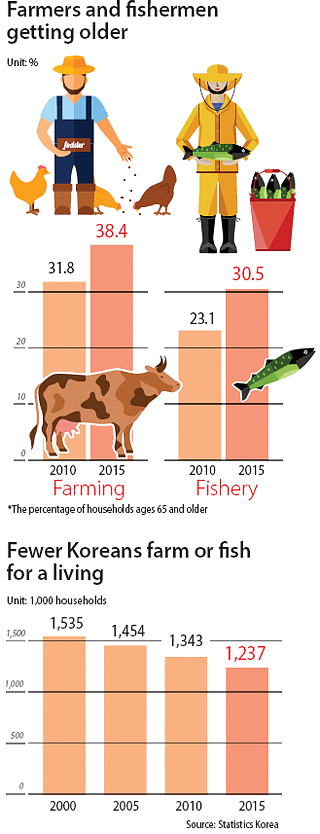Farmers, fishers grow older

The number of farming and fishery households in Korea fell 7.9 percent compared to 2010 to 1.24 million as of December, and they accounted for 6.5 percent of the total number of households, a drop of 1.2 percentage points.
The average age of Koreans who run farms and fishery businesses was 65.3 years old last year, up 3.3 years compared to five years ago, the government said Monday.
“The number of farmers and fishermen over 65 is growing faster than the general population and they accounted for 37.8 percent of the total number of Koreans working in the same industries,” said Lee Jae-won, a director at Statistics Korea. “A 37.8 percent share is 290 percent more than that of the general population. The number of farmers and fishermen has also dropped due to the aging society and as the country becomes more industrialized.”
In fact, the number of those who farm or fish for a living dropped 16.4 percent compared to five years ago to 2.92 million in 2015. The number of women was 2.5 percent higher than men.
Agricultural farmers were concentrated mainly in North Gyeongsang and South Jeolla. According to the data, there were 185,000 farming households in North Gyeongsang, accounting for 17 percent of the total farming households. South Jeolla had 150,000 households, which accounted for 13.8 percent of the total, and South Chungcheong had 132,000, accounting for 12.1 percent.
However, the number of farmers fell the most in South Chungcheong with 12.8 percent compared to 2010. The number of farmers declined 11.8 percent in South Jeolla and 11.6 percent in Jeju.
Even though there are more farmers who grow rice than any other crop, their number has also decreased.
“They are changing their crops to either fruits or mushrooms since they are more profitable,” said Lee at the statistics agency.
The number of rice farmers accounted for 41.7 percent, but the total dropped 2.7 percentage points compared to five years ago, while the number of farmers growing grains and fruits rose 2.8 percentage points and 1.3 percentage points respectively during the same period.
Farmers with yearly sales more than 50 million won ($45,220) rose 1.1 percentage points to 7.8 percent of the total number. However, those who earn less than 10 million won still represented the majority, accounting for 67.9 percent of the total.
South Jeolla was where the highest number of fishers lived. There were 18,800 fishery households in the region, followed by South Gyeongsang with 94,000 and South Chungcheong with 8,200.
Data also showed that the basic standard of living of Korean fishermen and farmers has improved in the past five years.
The number of farmers with vehicles rose 14.4 percentage points compared to 2010 to 86.1 percent of farming households. The figure for fishery households also rose 12.7 percentage points to 81.3 percent.
The number of those with flush toilets and water supply facilities rose significantly as well.
BY KIM YOUNG-NAM [kim.youngnam@joongang.co.kr]










with the Korea JoongAng Daily
To write comments, please log in to one of the accounts.
Standards Board Policy (0/250자)